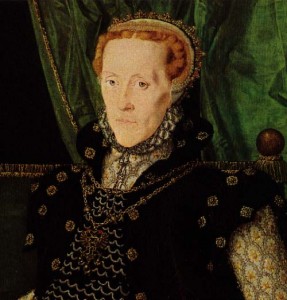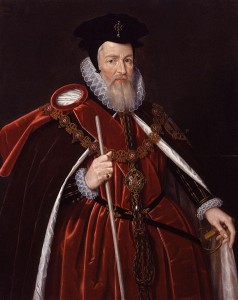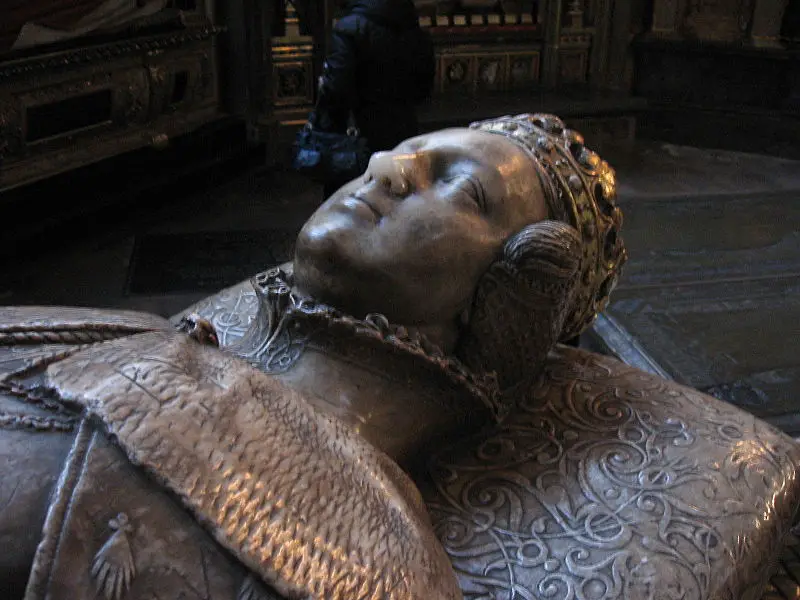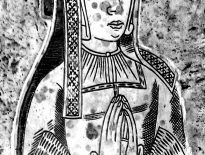 Mildred Cooke came from the influential Cooke family of Gidea Hall, Essex, a household renowned for its links with Renaissance humanism and reformist sympathies. Her father, Sir Anthony Cooke, was a royal tutor to King Edward VI; shaping the boy king’s interest in classical learning and Protestantism. Mildred’s sisters: Anne, Catherine and Elizabeth became renowned female scholars, with Anne famously translating from Latin John Jewel’s Apologie of the Anglican Church (1564). While the Cooke women were in the minority in terms of female education, (Thomas More’s daughter Margaret, and his wards, received humanist educations) their education did not mirror their male contemporaries. Sixteenth-century European scholars and clergyman dictated that women were naturally defective and immoral in comparison with virtuous, honourable men. However Humanist educators, such as Juan Luis Vives, understood the importance of educating women. He stressed that their curriculum should avoid ‘masculine’ studies such as mathematics, science and government. Rather, he recommended studying theological translations, languages and the moral philosophers of antiquity such as Plato and Cicero; topics that would not ‘corrupt’ the innate weakness of the female sex.
Mildred Cooke came from the influential Cooke family of Gidea Hall, Essex, a household renowned for its links with Renaissance humanism and reformist sympathies. Her father, Sir Anthony Cooke, was a royal tutor to King Edward VI; shaping the boy king’s interest in classical learning and Protestantism. Mildred’s sisters: Anne, Catherine and Elizabeth became renowned female scholars, with Anne famously translating from Latin John Jewel’s Apologie of the Anglican Church (1564). While the Cooke women were in the minority in terms of female education, (Thomas More’s daughter Margaret, and his wards, received humanist educations) their education did not mirror their male contemporaries. Sixteenth-century European scholars and clergyman dictated that women were naturally defective and immoral in comparison with virtuous, honourable men. However Humanist educators, such as Juan Luis Vives, understood the importance of educating women. He stressed that their curriculum should avoid ‘masculine’ studies such as mathematics, science and government. Rather, he recommended studying theological translations, languages and the moral philosophers of antiquity such as Plato and Cicero; topics that would not ‘corrupt’ the innate weakness of the female sex.
In terms of languages, Mildred was an outstanding linguist. In 1550, Roger Ascham, also tutor to Edward VI, described her as speaking Greek as fluently as English; considering her and Lady Jane Grey as England’s most learned ladies. Her family were renowned for their links with Protestant circles and families, such as the Stanhopes. Mildred dedicated her translation of St. Basil’s sermon to the formidable Anne Stanhope, the second wife of Edward Seymour, uncle of Edward VI. While evidently pious, Mildred’s passion for cementing her status through textiles should not be underestimated. While her faith was bordering on puritanism, which emphasised faith through scripture and a general disassociation with earthly indulgences, she enjoyed apparelling herself in fine clothing. Her husband, William Cecil, and herself attended the sale of Anne of Cleves’ effects at Chelsea in August 1557, purchasing three rich kirtles ornamented with pearls, heavy embroidery and cloth of silver. Additionally, Lady Burghley was an avid hawker and a physically strong woman. In 1562 she received a present of an Irish goshawk and frequently rode between Theobalds (the lavish family home of the Cecil family) and Westminster, with her daughter Anne. Similarly, she was trusted by her husband to remain in control of their household financial affairs when he travelled to Flanders in 1555.
Mildred Cooke married William Cecil as his second wife in December 1545. The marriage was ideal, in terms of their status and production of children. She had one son and heir, Robert Cecil, alongside two daughters, Anne and Elizabeth, who had made good marriages to the Earl of Oxford and William Wentworth, respectively. The marriage between Lord and Lady Burghley was particularly healthy, as will later be discussed in terms of his epitaph in her honour. She was particularly fond of her husband’s interest in gardening, and one of her Greek poems supports this, states ‘when sensible men arose, the much-branching forest gave a woodland for the blossoming garden. Now a wise man has made from the vast forest a lovely garden, in the woods arranging a garden that you see’. They also shared a mutual interest in learning, with her father bequeathing her several books upon his death. Mildred likely put these in what was becoming one of the most enviable libraries in England, containing books on classical and theological literature. She read widely, from contemporary sixteenth-century humanists, such as Erasmus, to medieval romantic literature such as Boccaccio. Seventeen of her books in Latin, Greek, French and English are still in existence and remain in the collection at Hatfield House in Hertfordshire.
Alongside maintaining an impressive library, the concept of gift-giving was a popular, ceremonial event that dominated the Tudor social calendar. As Historian Maria Hayward has suggested, it confirmed friendship and loyalty while also expressing one’s wealth and status within courtly society. Lady Burghley was known to be generous, gifting two valuable books each to St John’s College, Oxford, and to Westminster school. Similarly, in 1581, she presented to St Johns Cambridge an eight-volume bible, bound with bosses and a central medallion inscribed with her name. Not only can this be viewed as a representation of her respect and love for learning, and the institutions that promoted these values, but also as a means of cementing her status. The Cecils were evidently in a financial position to reward the universities with such expensive gifts. They, therefore, represented Lady Burghley’s academic interests while also emphasising her wealth and status through the embossment of her name on the front of each volume; a permanent reminder of who the pious gift-giver was. Alongside gifting, she was respected to the degree of having books dedicated to her honour. This included Thomas Drant’s ‘A Medicinable Moral, that is, two Books of Horace and his satires’ (1566).

William Cecil, her husband
To the shock of the English court, the Cecils’ eldest daughter, Anne, Lady Oxford, died suddenly of fever in the royal palace at Greenwich in March 1588. Untraditionally, Anne was interred in Westminster Abbey; a prestigious location which represented her father’s influence with the queen. Anne’s grand funeral was lavish and attended by an enormous number of courtiers, dignitaries and mourners. Equally, when Lady Burghley died on 4th April 1589, her funeral was followed by three hundred and seventeen mourners. As was expected with royal funerals, they were performed as ceremonial demonstrations of power, with Cecil capitalising on this concept. Both Anne and Mildred’s funerals reaffirmed their status in death through being laid to rest in the exclusive Westminster Abbey. Their joint tomb, with Mildred’s granddaughters being added in the seventeenth century, is a magnificent, physical statement in honour of the Cecil dynasty. It has inscribed on it an exceptionally long epitaph written by Cecil. As a statesman known for his writings and letter keeping, this does not seem particularly unusual. It is a tribute to the mortal successes of Mildred’s life; a woman who lived with him ‘constantly and harmoniously for 43 years and shared all my fortune in times good and bad’. The epitaph continues to pay tribute to her charitable pursuits and her learnedness in the tongues of Greek and Latin. Overall, Mildred Cecil led a multi-faceted life. She was evidently respected by the queen as an influential member of the Elizabethan court, and admired for both her virtuous countenance and as a learned, intelligent woman. Her death had an evident, detrimental effect on the well-being of her husband, who a year earlier had lost both his daughter and his mother. According to historian Pauline Croft, Lord Cecil was left ‘oppressed with the greatest grief’. Lord Burghley would later die in 1598 at the age of almost seventy-eight.
By Alexander Taylor
Sources used
- Bowden, Catherine, "Cecil (nee Cooke), Mildred, Lady Burghley (1526-1589), noblewoman and Scholar". Oxford Dictionary of National Biography. Accessed 26th May 2018. http://www.oxforddnb.com/view/10.1093/ref:odnb/9780198614128.001.0001/odnb-9780198614128-e-46675
- Croft, Pauline, ‘Mildred, Lady Burghley: The Patriarch’, ed. Patronage, Culture and Power: The Early Cecils 1558-1612 (New Haven: Yale University Press, 2002).
- Mears, Natalie, The Politics in the Elizabethan Privy Chamber: Lady Mary Sidney and Kat Ashley, ed. Women and Politics in early modern England (Aldershot: Ashgate 2004).
- Ross, Sarah, The Birth of Feminism: Woman as intellect in Renaissance Italy and England (Harvard University Press, 2009).



It’s good to hear about this intelligent lady who gets few mentions in history. She was a fit match for Cecil. I wonder what their pillow talk was like!
The Cookes are one of my very favourite Tudor families so I have a soft spot for Mildred. I’d love to have seen her library.